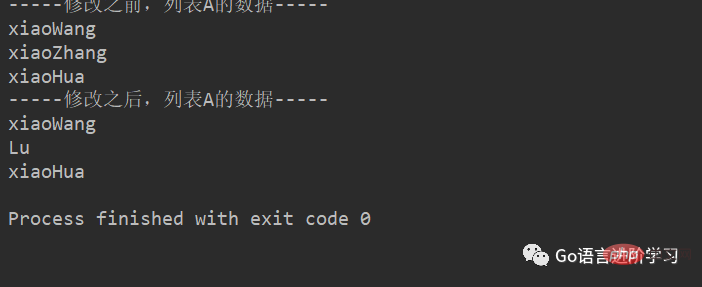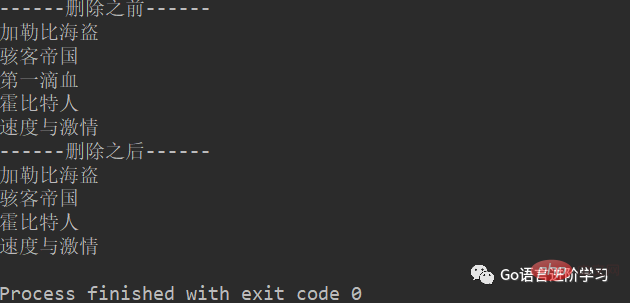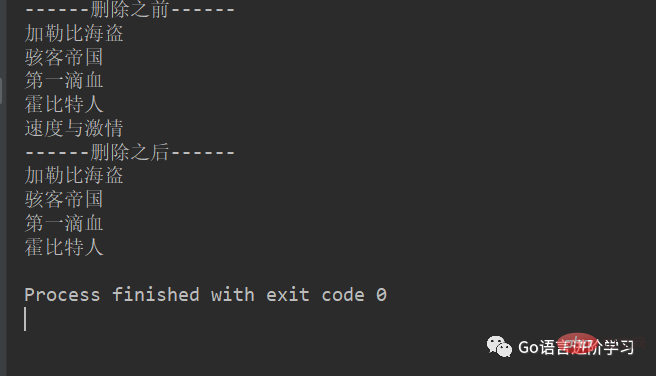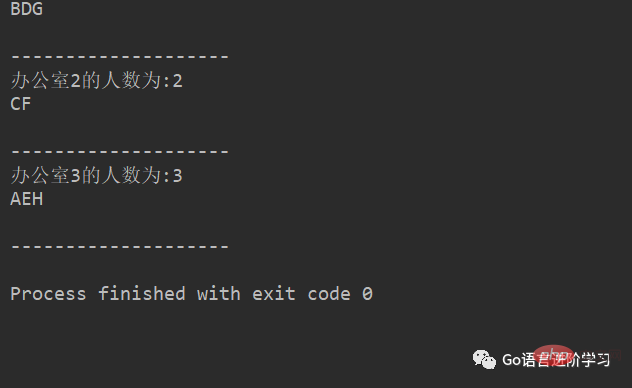 Backend Development
Backend Development
 Python Tutorial
Python Tutorial
 An article to help you understand the basics of Python list-related operations and nesting
An article to help you understand the basics of Python list-related operations and nesting
An article to help you understand the basics of Python list-related operations and nesting
1. List-related operations
The data stored in the list can be modified, such as "add", "delete", and "change".
<1> Add elements ("add" three ways to add)
1. append()
You can add elements to the list through append.
#定义变量A,默认有3个元素
A = ['xiaoWang','xiaoZhang','xiaoHua']
print("-----添加之前,列表A的数据-----")
for tempName in A:
print(tempName)
#提示、并添加元素
temp = input('请输入要添加的学生姓名:')
A.append(temp)
print("-----添加之后,列表A的数据-----")
for tempName in A:
print(tempName)Result:

2. extend()
You can add elements from another collection to the list one by one through extend
>>> a = [1, 2] >>> b = [3, 4] >>> a.append(b) >>> print(a) [1, 2, [3, 4]] #运行结果 >>> a.extend(b) >>> print(a) [1, 2, [3, 4], 3, 4] #运行结果
3 .insert()
insert(index, object) Inserts the element object
before index at the specified position.>>> a = [0, 1, 2] >>> a.insert(1, 3) >>> print(a) [0, 3, 1, 2]
<2> 修改元素("改")
修改元素的时候,要通过下标来确定要修改的是哪个元素,然后才能进行修改
demo:
# 定义变量A,默认有3个元素
A = ['xiaoWang', 'xiaoZhang', 'xiaoHua']
print("-----修改之前,列表A的数据-----")
for tempName in A:
print(tempName)
# 修改元素
A[1] = 'Lu'
print("-----修改之后,列表A的数据-----")
for tempName in A:
print(tempName)结果:

<3> 查找元素("查"in, not in, index, count)
所谓的查找,就是看看指定的元素是否存在。
1. in, not in
Python中查找的常用方法为:
in(存在),如果存在那么结果为true,否则为false。
not in(不存在),如果不存在那么结果为true,否则false。
#待查找的列表
nameList = ['xiaoWang','xiaoZhang','xiaoHua']
#获取用户要查找的名字
findName = input('请输入要查找的姓名:')
#查找是否存在
if findName in nameList:
print('在字典中找到了相同的名字')
else:
print('没有找到')运行结果:(找到)

运行结果:(没有找到)

说明:
in的方法只要会用了,那么not in也是同样的用法,只不过not in判断的是不存在。
2. index, count
index和count与字符串中的用法相同
>>> a = ['a', 'b', 'c', 'a', 'b'] >>> a.index('a', 1, 3) # 注意是左闭右开区间 Traceback (most recent call last): File "<stdin>", line 1, in <module> ValueError: 'a' is not in list >>> a.index('a', 1, 4) >>> print(a) 3 #运行结果 >>> a.count('b') >>> print(a) 2 #运行结果 >>> a.count('d') >>> print(a) 0 #运行结果
<4> 删除元素("删"del, pop, remove)
列表元素的常用删除方法有:
del:根据下标进行删除
pop:删除最后一个元素
remove:根据元素的值进行删除
1. del
movieName = ['加勒比海盗','骇客帝国','第一滴血','霍比特人','速度与激情']
print('------删除之前------')
for tempName in movieName:
print(tempName)
del movieName[2]
print('------删除之后------')
for tempName in movieName:
print(tempName)结果:

2. pop
movieName = ['加勒比海盗','骇客帝国','第一滴血','霍比特人','速度与激情']
print('------删除之前------')
for tempName in movieName:
print(tempName)
movieName.pop()
print('------删除之后------')
for tempName in movieName:
print(tempName)结果:

3. remove
movieName = ['加勒比海盗','骇客帝国','第一滴血','指环王','霍比特人','速度与激情']
print('------删除之前------')
for tempName in movieName:
print(tempName)
movieName.remove('指环王')
print('------删除之后------')
for tempName in movieName:
print(tempName)结果:

<5> 排序(sort, reverse)
sort方法是将list按特定顺序重新排列,默认为由小到大,参数reverse=True可改为倒序,由大到小。
reverse方法是将list逆置。
>>> a = [1, 4, 2, 3] >>> print(a) [1, 4, 2, 3] #运行结果 >>> a.reverse() >>> print(a) [3, 2, 4, 1] #运行结果 >>> a.sort() >>> print(a) [1, 2, 3, 4] #运行结果 >>> a.sort(reverse=True) >>> print(a) [4, 3, 2, 1] #运行结果
二、列表的嵌套
1. 列表嵌套
类似while循环的嵌套,列表也是支持嵌套的。
一个列表中的元素又是一个列表,那么这就是列表的嵌套。
例:
Names= [['北京','甘肃'],
['南京','天津','广东'],
['山','上海']]2. 应用
小项目练习:
学校,有3个办公室,现在有8位老师等待工位的分配,请编写程序,完成随机的分配。
#encoding=utf-8
import random
# 定义一个列表用来保存3个办公室
offices = [[],[],[]]
# 定义一个列表用来存储8位老师的名字
names = ['A','B','C','D','E','F','G','H']
i = 0
for name in names:
index = random.randint(0,2)
offices[index].append(name)
i = 1
for tempNames in offices:
print('办公室%d的人数为:%d'%(i,len(tempNames)))
i+=1
for name in tempNames:
print("%s"%name,end='')
print("\n")
print("-"*20)运行结果如下:

三、总结
本文详细的讲解了Python基础 ,介绍了常见的列表操作,以及在实际操作中会遇到的问题,提供了解决方案。最后通过一个小项目,使读者能够更好的理解Python列表的使用方法。希望可以帮助你更好的学习。
The above is the detailed content of An article to help you understand the basics of Python list-related operations and nesting. For more information, please follow other related articles on the PHP Chinese website!

Hot AI Tools

Undresser.AI Undress
AI-powered app for creating realistic nude photos

AI Clothes Remover
Online AI tool for removing clothes from photos.

Undress AI Tool
Undress images for free

Clothoff.io
AI clothes remover

Video Face Swap
Swap faces in any video effortlessly with our completely free AI face swap tool!

Hot Article

Hot Tools

Notepad++7.3.1
Easy-to-use and free code editor

SublimeText3 Chinese version
Chinese version, very easy to use

Zend Studio 13.0.1
Powerful PHP integrated development environment

Dreamweaver CS6
Visual web development tools

SublimeText3 Mac version
God-level code editing software (SublimeText3)

Hot Topics
 PHP and Python: Different Paradigms Explained
Apr 18, 2025 am 12:26 AM
PHP and Python: Different Paradigms Explained
Apr 18, 2025 am 12:26 AM
PHP is mainly procedural programming, but also supports object-oriented programming (OOP); Python supports a variety of paradigms, including OOP, functional and procedural programming. PHP is suitable for web development, and Python is suitable for a variety of applications such as data analysis and machine learning.
 Choosing Between PHP and Python: A Guide
Apr 18, 2025 am 12:24 AM
Choosing Between PHP and Python: A Guide
Apr 18, 2025 am 12:24 AM
PHP is suitable for web development and rapid prototyping, and Python is suitable for data science and machine learning. 1.PHP is used for dynamic web development, with simple syntax and suitable for rapid development. 2. Python has concise syntax, is suitable for multiple fields, and has a strong library ecosystem.
 Python vs. JavaScript: The Learning Curve and Ease of Use
Apr 16, 2025 am 12:12 AM
Python vs. JavaScript: The Learning Curve and Ease of Use
Apr 16, 2025 am 12:12 AM
Python is more suitable for beginners, with a smooth learning curve and concise syntax; JavaScript is suitable for front-end development, with a steep learning curve and flexible syntax. 1. Python syntax is intuitive and suitable for data science and back-end development. 2. JavaScript is flexible and widely used in front-end and server-side programming.
 PHP and Python: A Deep Dive into Their History
Apr 18, 2025 am 12:25 AM
PHP and Python: A Deep Dive into Their History
Apr 18, 2025 am 12:25 AM
PHP originated in 1994 and was developed by RasmusLerdorf. It was originally used to track website visitors and gradually evolved into a server-side scripting language and was widely used in web development. Python was developed by Guidovan Rossum in the late 1980s and was first released in 1991. It emphasizes code readability and simplicity, and is suitable for scientific computing, data analysis and other fields.
 Can vs code run in Windows 8
Apr 15, 2025 pm 07:24 PM
Can vs code run in Windows 8
Apr 15, 2025 pm 07:24 PM
VS Code can run on Windows 8, but the experience may not be great. First make sure the system has been updated to the latest patch, then download the VS Code installation package that matches the system architecture and install it as prompted. After installation, be aware that some extensions may be incompatible with Windows 8 and need to look for alternative extensions or use newer Windows systems in a virtual machine. Install the necessary extensions to check whether they work properly. Although VS Code is feasible on Windows 8, it is recommended to upgrade to a newer Windows system for a better development experience and security.
 Can visual studio code be used in python
Apr 15, 2025 pm 08:18 PM
Can visual studio code be used in python
Apr 15, 2025 pm 08:18 PM
VS Code can be used to write Python and provides many features that make it an ideal tool for developing Python applications. It allows users to: install Python extensions to get functions such as code completion, syntax highlighting, and debugging. Use the debugger to track code step by step, find and fix errors. Integrate Git for version control. Use code formatting tools to maintain code consistency. Use the Linting tool to spot potential problems ahead of time.
 How to run python with notepad
Apr 16, 2025 pm 07:33 PM
How to run python with notepad
Apr 16, 2025 pm 07:33 PM
Running Python code in Notepad requires the Python executable and NppExec plug-in to be installed. After installing Python and adding PATH to it, configure the command "python" and the parameter "{CURRENT_DIRECTORY}{FILE_NAME}" in the NppExec plug-in to run Python code in Notepad through the shortcut key "F6".
 Is the vscode extension malicious?
Apr 15, 2025 pm 07:57 PM
Is the vscode extension malicious?
Apr 15, 2025 pm 07:57 PM
VS Code extensions pose malicious risks, such as hiding malicious code, exploiting vulnerabilities, and masturbating as legitimate extensions. Methods to identify malicious extensions include: checking publishers, reading comments, checking code, and installing with caution. Security measures also include: security awareness, good habits, regular updates and antivirus software.





